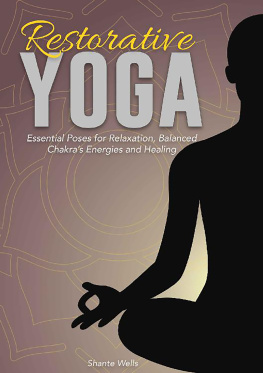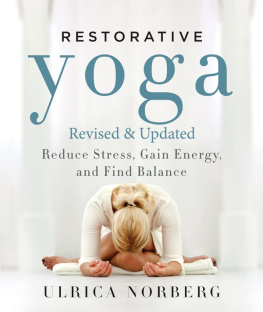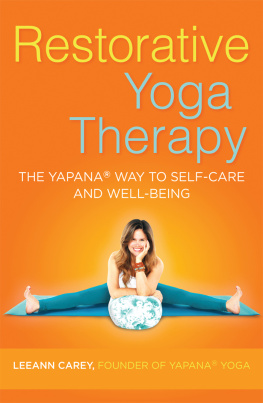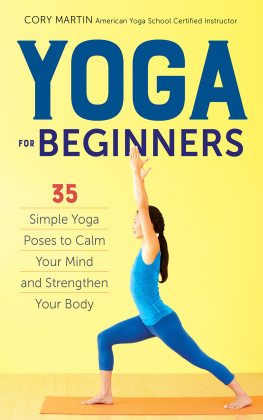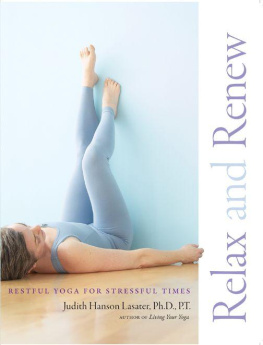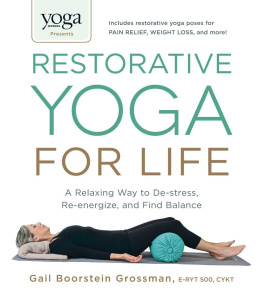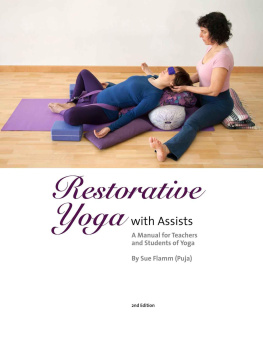RESTORATIVE YOGA
ESSENTIAL POSES FOR RELAXATION, BALANCED CHAKRA ENERGIES AND HEALING.
Copyright 2020 by Shante Wells
All rights reserved.
This document is geared towards providing exact and reliable information with regards to the topic and issue covered. The publication is sold with the idea that the publisher is not required to render accounting, officially permitted, or otherwise, qualified services. If advice is necessary, legal or professional, a practiced individual in the profession should be ordered.
- From a Declaration of Principles which was accepted and approved equally by a Committee of the American Bar Association and a Committee of Publishers and Associations.
In no way is it legal to reproduce, duplicate, or transmit any part of this document in either electronic means or in printed format. Recording of this publication is strictly prohibited and any storage of this document is not allowed unless with written permission from the publisher. All rights reserved.
The information provided herein is stated to be truthful and consistent, in that any liability, in terms of inattention or otherwise, by any usage or abuse of any policies, processes, or directions contained within is the solitary and utter responsibility of the recipient reader. Under no circumstances will any legal responsibility or blame be held against the publisher for any reparation, damages, or monetary loss due to the information herein, either directly or indirectly.
Respective authors own all copyrights not held by the publisher.
The information herein is offered for informational purposes solely, and is universal as so. The presentation of the information is without contract or any type of guarantee assurance.
The trademarks that are used are without any consent, and the publication of the trademark is without permission or backing by the trademark owner. All trademarks and brands within this book are for clarifying purposes only and are the owned by the owners themselves, not affiliated with this document
TABLE OF CONTENTS
Page 4 - INTRODUCTION
Page 9 - CLEAR AND BALANCE CHAKRA ENERGIES
Page 16 - REDUCE ANXIETY
Page 20 - LOW-STRESS LEVELS
Page 27 - INCREASE FLEXIBILITY
Page 43 - MAINTAIN OR IMPROVE RANGE OF MOTION AND CIRCULATION
Page 45 - REALIGN THE PELVIS
Page 49 - STRENGTHEN WEAK MUSCLES
Page 53 - INCREASE ENERGY
Page 57 - ELEVATE MOOD AND RELIEVE SADNESS AND DEPRESSION
Page 64 - RELEASE NEGATIVE OR STAGNANT ENERGY AND EMOTIONS
Page 70 - MAINTAIN OR IMPROVE THE HEALTH OF THE JOINTS
Page 73 - CONCLUSION
INTRODUCTION
Restorative yoga is an exercise that revolves around slowing down and opening the body through passive stretching. If you're in a therapeutic class, you can barely move, with just a few posts over an hour. It is a very different experience from most contemporary yoga. Most yoga classes are an active exercise in which you move from pose to pose, build heat, and increase your strength and flexibility equally. The general trend in yoga is more athletic and acrobatic practice styles. During long restorative yoga periods, your muscles can relax deeply. It is a unique feeling because the accessories, instead of your flesh, are used to support your body. Restorative classes are very gentle, making them an excellent addition to increasingly dynamic practices (just as our bustling lives) and a great counteractant to stretch. Silence is a powerful exercise.
Clinical research on restorative yoga has shown that it can reduce depression in cancer survivors; improve symptoms of anxiety, depression, and pain in cancer patients; and help patients control the toxicity of cancer treatments. Restorative yoga is a safe, gentle, and gentle practice that can help you learn to relax and recharge. You also cultivate the essential skills of self-awareness. More and more research is published on the benefits of 'stress reduction' techniques such as yoga and meditation. Taking time to break free from the tension, breathe, and focus your attention can be a welcome (and sometimes rare) break from the faster pace of modern life.
A central theme of yoga is to experience a balance between effort and ease. In restorative yoga, we balance the luxury of living in silence and relaxation with sustained, lively, and focused attention. These two components cooperate to make a pleasant and engaging experience. Typically, a therapeutic class focuses on spending long periods relaxing and breathing relaxing yoga poses, although an exercise may include some gentle movements. Restorative yoga is safe and accessible to more people due to the use of 'accessories' to support the postures. You can use blankets, pillows (large pillows), blocks, and straps to effortlessly sit in different poses. (More on accessories in a moment).

Some general guidelines are:
Although most of these poses are gentle, if you have physical concerns, talk to your doctor about integrating yoga into your lifestyle.
Give yourself enough time in the pose to feel good. Get comfortable so you can rest in any position for at least five minutes, longer if you feel good.
Also, take the time to get out of the poses. Don't rush to move or stand up again. Be present for the different feelings of silence and smooth movements.
Keep it simple. As you relax, you will notice your attention drift. Stay relaxed and breathe, again focusing your attention on the feeling of letting go and the subtle movements of your breathing.
I am happy to share my restorative practice with you. Every week I see how this gentle practice can change a person's feelings, not only physically, but also at the level of the intellect, emotion, psyche/mind.
avsana, or corpse pose, may be familiar to you if you have taken yoga classes in a studio or gym. This 'last relaxation pose' generally lasts for five to fifteen minutes and means that you rest on your back, consciously relax the tension and strain on yourself, and breathe gently. I always start and end my recovery lesson with this pose.
It is the simple and unadorned experience of paying attention to yourself over some time, noticing how you feel the tension and how much you can release it. I encourage you to spend at least ten minutes in avsana. Give yourself time to feel relaxed and focused on your breathing. Be patient and just enjoy being with yourself, realizing it.
It takes a long time to get out of the pose: remember how much time and care you spend going into softness and silence. Keep those properties smooth, even as you begin to move slowly, starting with your fingers and toes and gradually spreading the movements to all the joints, to yourself. Be there and enjoy the feeling of 'bringing life' back to your bones and muscles. Surround yourself by your side and enjoy some relaxed breaths before slowly rolling up to spend some time sitting. Practicing yoga can be like having a conversation with yourself: noticing, answering, asking questions, learning. I hope we can start our discussion, using these videos and their experiences for dialogue.

What is restorative yoga?
Restorative yoga is a feeding type of yoga that extends profoundly, latently, and holds fewer postures for more extended periods. Unlike some of the more active or "yang" types of yoga, restorative yoga encourages us to slow down, let go, and suspend activities, both physical and mental. By doing this, it is an exercise that relaxes the body and mind, bridging the gap between the two. Restorative classes use accessories to promote maximum comfort, as students are invited to melt deeply into each pose.
Next page
